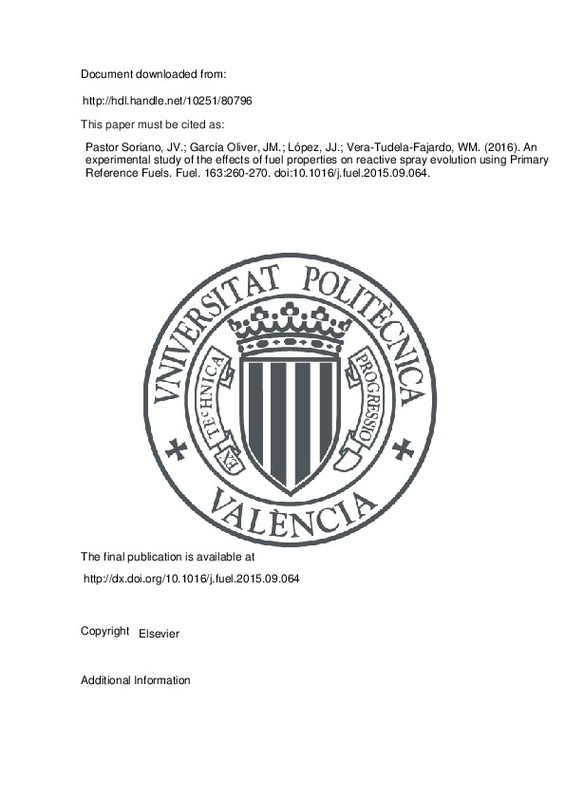JavaScript is disabled for your browser. Some features of this site may not work without it.
Buscar en RiuNet
Listar
Mi cuenta
Estadísticas
Ayuda RiuNet
Admin. UPV
An experimental study of the effects of fuel properties on reactive spray evolution using Primary Reference Fuels
Mostrar el registro sencillo del ítem
Ficheros en el ítem
| dc.contributor.author | Pastor Soriano, José Vicente
|
es_ES |
| dc.contributor.author | García Oliver, José María
|
es_ES |
| dc.contributor.author | López, J. Javier
|
es_ES |
| dc.contributor.author | Vera-Tudela-Fajardo, Walter Martin
|
es_ES |
| dc.date.accessioned | 2017-05-10T07:57:54Z | |
| dc.date.available | 2017-05-10T07:57:54Z | |
| dc.date.issued | 2016-01-01 | |
| dc.identifier.issn | 0016-2361 | |
| dc.identifier.uri | http://hdl.handle.net/10251/80796 | |
| dc.description.abstract | An experimental study on the ignition and combustion of diesel-type sprays using n-heptane, iso-octane and four intermediate blends is presented. The choice of components was done in order to represent the transition from conventional diesel fuel (n-heptane) to a gasoline-like one (iso-octane) in terms of ignition behavior. The experiments have been carried out in a high pressure high temperature vessel using specifications from the Engine Combustion Network (ECN). Parametric variations of oxygen concentration and air temperature have been performed for each fuel. In order to investigate the spray development, schlieren imaging for the quantification of spray penetration and ignition delay, OH/chemiluminescence imaging for the lift-off length, and broadband radiation imaging for the soot intensity and flame length have been applied. The results show the large effect of mixture reactivity on the ignition times and lift-off length values. Regarding the effect of the octane number of the blends on the ignition delay times, a linear effect has been found in the lower half of the blend range, while an exponential trend is evident in the top one. On the other hand, a scaling law for the stabilized flame length based upon momentum-controlled assumptions has shown that results are comparable to those obtained in the literature. Finally, the applicability of the results obtained on the performance and efficiency in real engines is discussed. (C) 2015 Elsevier Ltd. All rights reserved. | es_ES |
| dc.description.sponsorship | Authors acknowledge that part of this work was performed in the frame of Project DUFUEL TRA2011-26359, funded by the Spanish Government. Also, authors would like to thank the Pontificia Universidad Catolica del Peru for financing the first year of studies of W. Vera-Tudela and making it possible for him to start his program of Ph.D. at the Universitat Politecnica de Valencia. | en_EN |
| dc.language | Inglés | es_ES |
| dc.publisher | Elsevier | es_ES |
| dc.relation.ispartof | Fuel | es_ES |
| dc.rights | Reserva de todos los derechos | es_ES |
| dc.subject | Primary Reference Fuel,Diesel spray,Ignition,Combustion,Lift-off length | es_ES |
| dc.subject.classification | MAQUINAS Y MOTORES TERMICOS | es_ES |
| dc.title | An experimental study of the effects of fuel properties on reactive spray evolution using Primary Reference Fuels | es_ES |
| dc.type | Artículo | es_ES |
| dc.identifier.doi | 10.1016/j.fuel.2015.09.064 | |
| dc.relation.projectID | info:eu-repo/grantAgreement/MICINN//TRA2011-26359/ES/COMBUSTION EFICIENTE Y LIMPIA EN MOTORES DE ENCENDIDO POR COMPRESION UTILIZANDO EL CONCEPTO DUAL-FUEL/ | es_ES |
| dc.rights.accessRights | Abierto | es_ES |
| dc.contributor.affiliation | Universitat Politècnica de València. Escuela Técnica Superior de Ingeniería del Diseño - Escola Tècnica Superior d'Enginyeria del Disseny | es_ES |
| dc.description.bibliographicCitation | Pastor Soriano, JV.; García Oliver, JM.; López, JJ.; Vera-Tudela-Fajardo, WM. (2016). An experimental study of the effects of fuel properties on reactive spray evolution using Primary Reference Fuels. Fuel. 163:260-270. https://doi.org/10.1016/j.fuel.2015.09.064 | es_ES |
| dc.description.accrualMethod | S | es_ES |
| dc.relation.publisherversion | http://dx.doi.org/10.1016/j.fuel.2015.09.064 | es_ES |
| dc.description.upvformatpinicio | 260 | es_ES |
| dc.description.upvformatpfin | 270 | es_ES |
| dc.type.version | info:eu-repo/semantics/publishedVersion | es_ES |
| dc.description.volume | 163 | es_ES |
| dc.relation.senia | 307056 | es_ES |
| dc.contributor.funder | Ministerio de Ciencia e Innovación | es_ES |







![[Cerrado]](/themes/UPV/images/candado.png)

